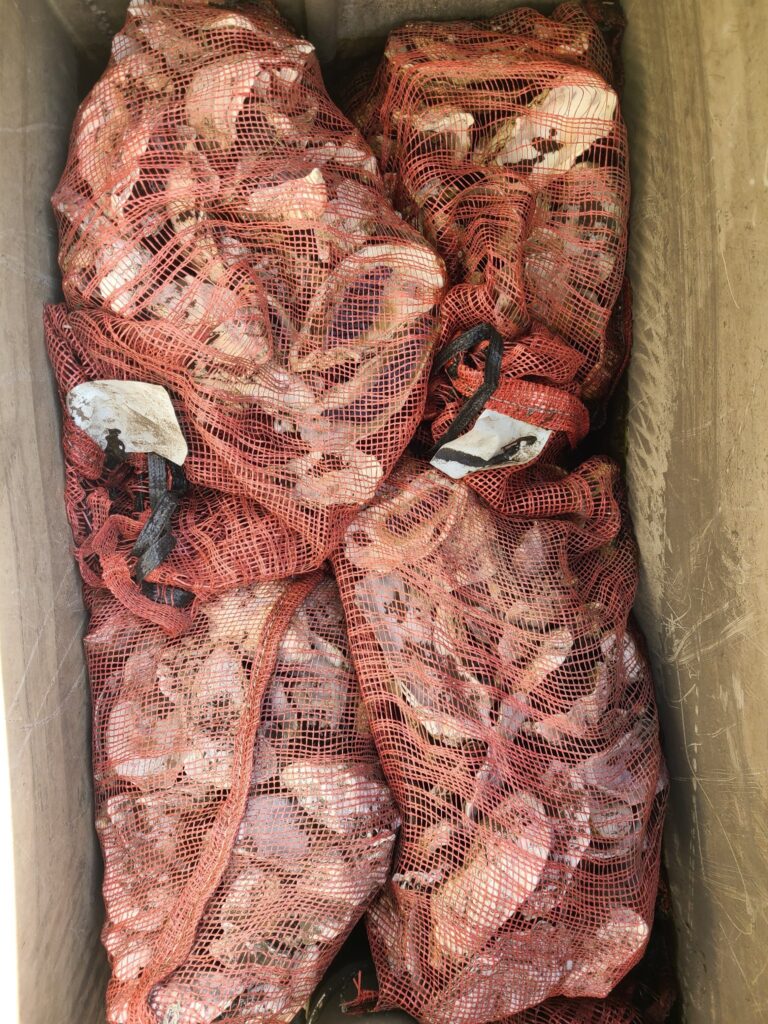Oyster Shells & Oyster Chips
We at Gullywasher are always looking for better treatments for increasing stormwater purity. Sometimes it is best to look upstream and into ways to take out the bulk load of the stormwater contamination. This allows your main stormwater treatment process to be online longer, reduce its monthly maintenance requirements, extend the life cycle of its media…
Yes, I understand the attraction of our one-stop process. And most of the time, using our process concepts works well! Yet industrial stormwater is complicated for all of its contaminates go up and down independently like working a yo-yo on a roller coaster. It can be due to extra loading of heavy truck deliveries (copper, zinc, TSS), the extra sun on your metal roofs (dissolved zinc), the lack of adequate surface sweeping that week (everything)… The list goes on and on.
When I first heard about oyster shells being used in catch basins and downspout filters, I was a major skeptic – I mean, come on, oyster shells?! No way! But after years of denial, I finally had to accept the truth: these shells are absolute stormwater-cleaning rock stars, even though I’m still not entirely sure how they work. And to top it off, the lab numbers are simply mind-blowing!
Check out these consistently great stats from an Oregon client of ours – keeping in mind that there is a biochar biofilter receiving this effluent for further polishing:
| Analyte | Sample Date | Flow | Inlet Flow – mg/L | Oyster Shell Outlet – mg/L | Oyster Shell % removal |
| Aluminum | 10/14/2021 | 80 gpm | 9.82 | 4.18 | 57.4% |
| 11/19/2021 | 80 gpm | 6.37 | 1.00 | 84.3% | |
| 12/22/2021 | 80 gpm | 11.40 | 1.54 | 86.5% | |
| 1/13/2022 | 80 gpm | 13.60 | 4.25 | 68.8% | |
| Average | 10.298 | 2.743 | 74.2% | ||
| Copper | 10/14/2021 | 80 gpm | 0.062 | 0.022 | 64.5% |
| 11/19/2021 | 80 gpm | 0.019 | 0.004 | 78.9% | |
| 12/22/2021 | 80 gpm | 0.034 | 0.0076 | 77.6% | |
| 1/13/2022 | 80 gpm | 0.0349 | 0.0125 | 64.2% | |
| Average | 0.037 | 0.012 | 71.3% | ||
| Iron | 10/14/2021 | 80 gpm | 34.3 | 7.52 | 78.1% |
| 11/19/2021 | 80 gpm | 11 | 2.49 | 77.4% | |
| 12/22/2021 | 80 gpm | 14.4 | 2.67 | 81.5% | |
| 1/13/2022 | 80 gpm | 16.3 | 4.67 | 71.3% | |
| Average | 19.000 | 4.338 | 77.1% | ||
| Zinc | 10/14/2021 | 80 gpm | 0.814 | 0.307 | 62.3% |
| 11/19/2021 | 80 gpm | 0.356 | 0.0693 | 80.5% | |
| 12/22/2021 | 80 gpm | 0.519 | 0.104 | 80.0% | |
| 1/13/2022 | 80 gpm | 0.504 | 0.148 | 70.6% | |
| Average | 0.548 | 0.157 | 73.4% |
As you can see, these shells are knocking it out of the park, reducing metal levels by at least 71% on average!
Now, let‘s talk about the two types of oyster shells available: Whole Shells and Shell Chips.

The actual preparation of either type takes years and a whole lotta waterfront space. After the oysters are shucked, there’s still some goo and muscle left behind. It takes a couple of years for nature‘s little scavengers to clean the shells completely. So they are left in piles for nature to do its work. Then it is our turn…
For whole oyster shells, we size them right, wash off the residue and dust, then pack them into poly mesh sacks, ready to be shipped out in palletized loads.
For oyster chips, on the other hand, need a bit more TLC. After denaturing the shells, we load them up into a partial crusher tuned to the rough shell size we want. Then these crushed shell fragments are graded for the specific shell size, hauled back for washing, and packed into cubic yard sacks, ready for shipping.
Why go for the chips? Simple: more surface area equals better performance, especially when you’re dealing with tight spaces, loads of contaminants, or high flow volumes. The catch? The extra processing means they’ll set you back a bit more than whole oyster shells.
So there you have it! Oyster shells, once the underdogs of stormwater treatment, are now cleaning up the scene, quite literally! Are you ready to join the oyster shell revolution and give your stormwater a serious makeover? Don’t wait another minute! Reach out to the scientists at Gullywasher and we will supply you with the perfect oyster shell solution for your needs.
So, reach out and let’s clean that stormwater!
